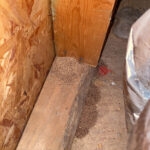Drywood termites are a major concern for homeowners in The Heights Houston, TX. These destructive pests can cause severe damage to wooden structures and furniture. They feed on cellulose found in wood, which is why they tend to attack wooden items around the home such as floors, walls, furniture, and even books or papers stored inside the home.
Drywood Termites are very habitual, they are going to enter your home in the same spots. Typically, that is your attic, window seals, door frames, and crawl spaces. Termites follow the path of least resistance, therefore, they will try and enter your home through the easiest form.
Drywood termites are attracted to moisture, and tend to look for sources of water near their nesting sites in order to survive. They can enter homes through small cracks in walls or through vents, so it is important to make sure that your home is well-sealed and properly maintained. If you suspect an infestation, it is important to have your home inspected by CPL Pest Control, professional pest control company.
Lets discuss some Drywood Termite facts and what makes your home a candidate this year for Drywood Termites! But first… lets look at what it looks like when we aggressively attack Drywood Termites and exterminate them!
Drywood termites have a three-stage life cycle that begins with an egg and ends with an adult. The eggs hatch into nymphs, which molt several times before reaching adulthood. As adults, they are small white or yellowish creatures about the size of a grain of rice. They may be difficult to spot, but their tunnels and droppings can give away their presence.
How Did I get to have Drywood Termites?
In most cases, the presence of drywood termites is due to an infestation from outside sources. Generally, these pests are brought into homes via furniture or items made of wood that have been exposed to dampness or humidity for extended periods of time. Additionally, they can also be carried in by birds, ants or other pests that may have been feeding on wood that has been infested with termites. The best way to prevent an infestation is to inspect any items made of wood brought in from outside the home, and to remove any sources of moisture or humidity.
How Do You Know If You Have a Drywood Termite Problem?
Drywood termites can cause a variety of signs and symptoms, including sawdust-like droppings, bubbling paint or wallpaper, and hollowed-out wood. If you see any of these signs in your home, it is important to take action immediately to prevent further damage.
What is Frass?

When drywood termites feed on wood, they leave behind a sawdust-like substance known as frass. This powdery material is made up of small particles of wood and feces. Frass can often be seen near the entry points of infested wood or around crevices in walls and floors.
Do Drywood Termites Consume a-lot of Wood?
Yes, drywood termites can consume large amounts of wood quickly. They have the ability to feed on both soft and hardwoods, so they can cause considerable damage in a short amount of time if left unchecked. For this reason, it is important to act quickly once you suspect an infestation.
How Can You Get Rid of Drywood Termites?
The best way to get rid of drywood termites is to have a professional pest control company treat your property. They will use specialized tools and techniques to locate and eliminate the infestation. We here at CPL Pest Control use the latest in technology to examine your home, see where you may have a problem, diagnose the situation, and do our best to present you with some options that are feasible.
What Should I Do If I Think I Have Drywood Termites?
So give us a call today for your FREE Inspection! We promise to do a thorough inspection of your home and give you the confidence you need in all of your pest control expectations. Give us a call at 281-683-6737 and as always… ASK FOR CHRIS for your special promotion!